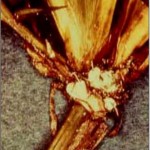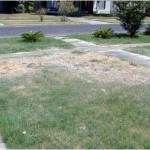The Rhodesgrass scale (also called Rhodesgrass mealybug) was introduced into the United States in 1942. Sixty-nine species of range, lawn and golf course grasses in much of southern and coastal Texas became infested, resulting in yield loss and plant death. The scale forms white cottony masses of wax, about 1/8 inch in diameter, at the base of the grass stem and in the leaf axis. A scale insect parasite, Neodusmetia sangwani, was introduced into Texas from India in 1959. Biological control of Rhodesgrass scale has been successful since that time. Help maintain biological control by minimizing the use of long residual insecticides.
Recently, soil mealybugs have been identified as a sugar resource for red imported fire ants:
Helms, K. R. and S. B. Vinson. 2002. Widespread association of the invasive Solenopsis invicta with an invasive mealybug. Ecology 83(9):2425-2438,
Ground pearls are subterranean scales that feed on the roots of grasses, primarily in west Texas. Scales are hard, globular and whitish to purplish and somewhat iridescent. They resemble small pearls and are up to 1/8 inch diameter. Their feeding causes grass to turn yellow and die. Damage occurs during the spring and dry periods of the year, when small, irregular areas of unthrifty or dead grass appear. No insecticide products are specifically registered for control of ground pearls in turfgrass (although malathion was suggested in a 1980 publication). Good cultural practices can help minimize damage from ground pearls. Avoid using infested sod when establishing a new planting.
Mystery Mealybug on Turfgrass
In August 2010 in San Antonio, Texas, an unidentified scale was observed in one lawn.
The mealybug produced excessive wax all along the leaves of the grass. It was small, much smaller than Rhodesgrass mealybug, and not down on stolons like bermudagrass scale. The identification remains unresolved (pers. com. J. Reinert).



